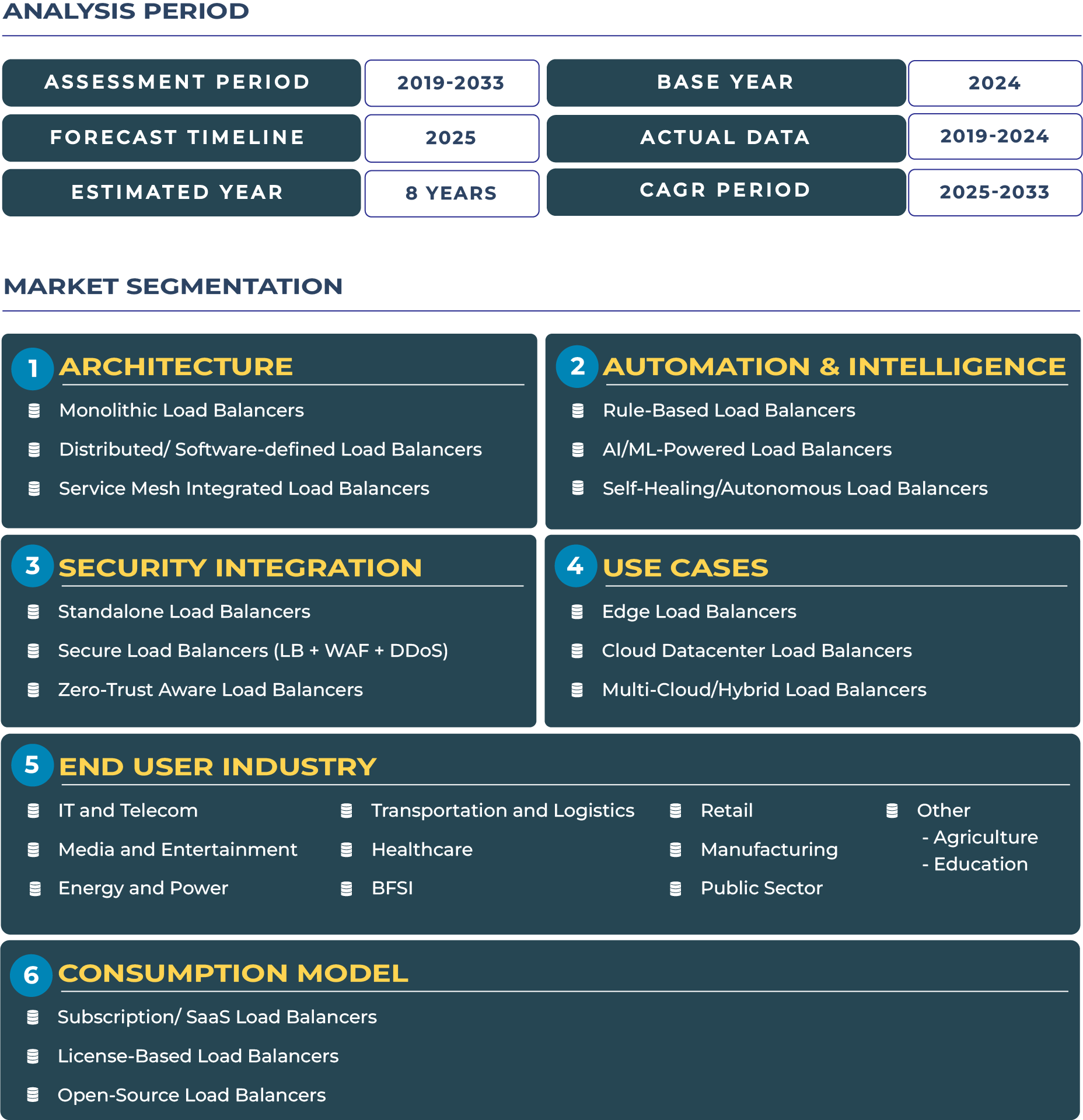Report Format:
![]()
![]() |
Pages: 110+
|
Pages: 110+
Energy-Led Smart Economy Transformation: Qatar Cloud Load Balancers Market Outlook
Qatar is positioning itself as a digitally empowered economy, using its energy wealth as a springboard for cloud-driven modernization. Investments linked to Ministry of Communications and Information Technology programs and sovereign strategies are fueling smart city initiatives, advanced data centers, and cloud-native workloads. Within this transformation, the cloud load balancers market is gaining traction, providing the backbone for secure, reliable, and scalable digital services across financial institutions, telco networks, and smart infrastructure. Unlike traditional monolithic infrastructure, distributed and service mesh–integrated load balancers are increasingly prioritized to support mission-critical workloads in high-demand sectors like finance, healthcare, and urban planning.
According to DataCube Research, the Qatar Cloud Load Balancers Market is expected to grow from USD 2.5 million in 2025 to USD 8.8 million by 2033, reflecting a CAGR of 16.8%. This robust performance is underpinned by sovereign cloud projects, investments in hyperscaler collaborations, and the digital legacy of major events such as the FIFA World Cup, which drove significant 5G and smart-stadium deployments. Despite global uncertainties such as geopolitical tensions and inflationary pressures, Qatar’s commitment to smart infrastructure keeps demand for cloud balancing solutions on a steady upward path.
Drivers & Restraints: Strategic Catalysts and Market Challenges Shaping Qatar’s Cloud Load Balancers Industry
Government Technology Expenditure and Smart Infrastructure Drive Growth
Qatar’s high government capital expenditure in technology has been instrumental in supporting the cloud load balancers ecosystem. From smart stadiums to e-government platforms, distributed and software-defined load balancers are used to secure applications and optimize traffic flow. The legacy of massive 5G deployments for global sporting events continues to shape demand, as telecom operators now repurpose infrastructure for smart city and enterprise applications. Furthermore, sovereign cloud initiatives led by national authorities create an anchor demand for high-grade traffic management solutions, offering long-term resilience for the cloud load balancers sector.
Concentration Risks and Limited Enterprise Diversity Slow Broader Uptake
However, the market also faces constraints. Qatar’s reliance on large-scale government projects and flagship infrastructure means market demand is concentrated in fewer projects, creating exposure to procurement cycles. The narrow enterprise base outside energy, finance, and government slows diversification of demand, particularly compared to larger Gulf economies. Vendor selection barriers, shaped by rigorous regulatory standards and sovereignty concerns, also limit the pace of adoption for some global players. These challenges underline the importance of balancing sovereign strategies with scalable enterprise solutions to expand the addressable market.
Trends & Opportunities: Cloud Load Balancers Powering Smart City and Edge-Driven Futures in Qatar
Smart-City Digitalization and Telco-Edge Expansion Shape Market Trends
The cloud load balancers industry in Qatar is closely tied to the nation’s smart city agenda, with projects in Lusail and Msheireb demonstrating the scale of digitization. Service mesh–integrated load balancers are particularly relevant here, ensuring microservices in IoT-heavy environments remain reliable and secure. Telco operators are expanding edge infrastructure to deliver low-latency experiences across healthcare, education, and e-government, strengthening the role of distributed load balancers. Government adoption of cloud-native architectures further accelerates demand, embedding load balancing into national IT modernization frameworks.
Opportunities in Smart Stadium Packages and Sovereign Service Modernization
Qatar presents unique opportunities for vendors who package solutions tailored to marquee projects such as smart stadiums and smart cities. Pre-integrated load balancer offerings with system integrators shorten deployment cycles, making them attractive for government-backed initiatives. Telecom-led edge deployments open pathways for co-developed load balancer services, particularly in collaboration with hyperscalers. Additionally, the modernization of sovereign digital services creates an opportunity for vendors to introduce compliance-oriented, secure, and high-performance load balancing as a core infrastructure offering in public sector digital transformation.
Competitive Landscape: Local Partnerships and Global Vendor Strategies Define Qatar’s Cloud Load Balancers Sector
The competitive landscape of Qatar cloud load balancers market is shaped by both international vendors and local partnerships. Global leaders like F5 Networks continue to anchor the market with advanced distributed solutions tailored for financial and sovereign workloads. Telecom operators in Qatar are increasingly forming partnerships with international vendors to co-develop edge-ready load balancer services, enhancing local ecosystem strength. Strategies such as packaging smart-city and smart-stadium solutions with system integrators are emerging as differentiators, enabling faster rollouts for high-profile projects. This alignment between global expertise and local delivery ensures that Qatar cloud load balancers sector remains positioned for rapid expansion in line with the country’s smart economy ambitions.







